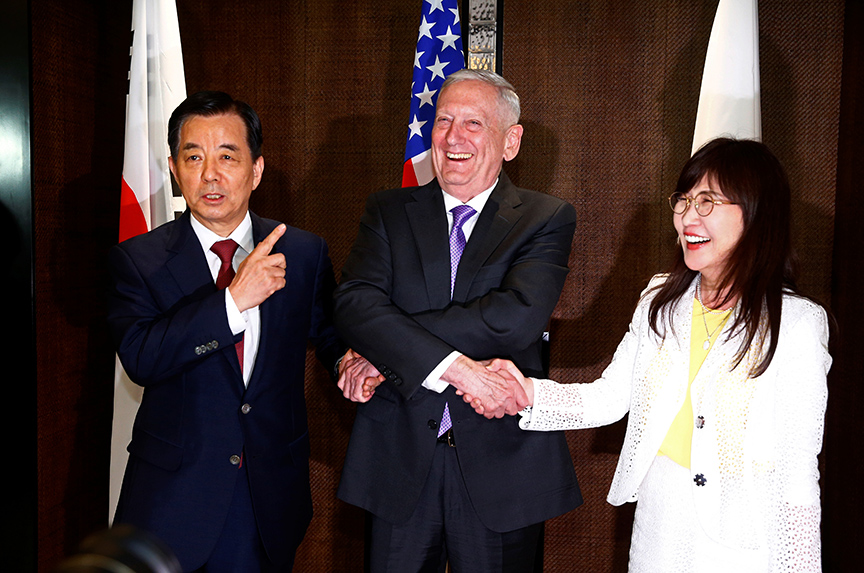 On June 3, US Defense Secretary James Mattis stepped into the spotlight at Asia’s premier annual security gathering to reassure America’s Asian friends about our commitment to regional peace and prosperity. His remarks at the Shangri-La Dialogue in Singapore sent a much-needed message of commitment to a jittery region. But in the halls, questions lingered over the US administration’s broader Asia strategy and, specifically, its approach to economic engagement.
On June 3, US Defense Secretary James Mattis stepped into the spotlight at Asia’s premier annual security gathering to reassure America’s Asian friends about our commitment to regional peace and prosperity. His remarks at the Shangri-La Dialogue in Singapore sent a much-needed message of commitment to a jittery region. But in the halls, questions lingered over the US administration’s broader Asia strategy and, specifically, its approach to economic engagement.
The Trump administration has distanced itself from its predecessor’s “rebalance” to Asia. In the era of “America First,” what will replace it? We have seen some hints about the US security role in Asia, but fewer details on trade and economics.
With 60 percent of the world’s population, over a third of global GDP, and five out of our top ten trading partners, Asia is critical to America’s future growth prospects and vice versa.
The Trans-Pacific Partnership (TPP) was the centerpiece of the Obama administration’s regional economic policy. In his first days in office, US President Donald J. Trump fulfilled a campaign pledge to withdraw from it. A twelve-country trade agreement we had a heavy hand in writing, the TPP covered about 40 percent of the world’s GDP. Its disciplines would have leveled the playing field for US workers and companies and established a high standard for a region that claimed nine of the world’s fifteen fastest-growing economies in 2016.
In its place, the Trump administration intends to negotiate a series of bilateral trade agreements. It’s early, but so far, no one in Asia has signed up to cut a deal. Emerging partners, who were ready under TPP to take steps like curbing the unfair trade practices of their state-owned companies and abiding by more stringent worker protections, are now taking a wait-and-see approach.
A patchwork of one-off agreements is no substitute for an open, rules-based economic architecture in Asia led by the United States. It doesn’t add up to a comprehensive regional strategy, nor is it likely to maximize benefits for US companies that face a bewildering array of trade and customs requirements. Nevertheless, deals that open individual markets to our exporters are preferable to no deals at all.
But linchpin allies, like Japan, have opted to move forward with TPP. In part, they are pinning their hopes on the United States eventually returning to the agreement it was instrumental in pulling across the finish line.
Their decision reflects the race underway to establish Asia’s rules of economic engagement. Negotiations to reach agreement on another regional trade deal with sixteen Asian countries are deliberately moving toward completion. It’s China, not the United States, that holds an outsized seat at those talks.
On the eve of the 70th anniversary of the US-led Marshall Plan to rebuild Europe after World War II, Chinese President Xi Jinping hosted a major global summit touting his country’s ambitious vision to help build and finance a massive trade infrastructure connecting Asia and Europe.
These developments should serve as a wake-up call for America. How can the United States reassert economic leadership in Asia?
We can start out by encouraging adoption of TPP’s many non-controversial provisions in other trade negotiations and as part of domestic reforms by Asian countries.
Asia-Pacific Economic Cooperation (APEC) is an excellent regional economic forum to pursue progress on cutting-edge issues such as digital trade and reducing behind-the-border restrictions that keep our products out of global supply chains and contribute to trade imbalances.
All eyes in the region are watching the Trump administration’s renegotiation of the North American Free Trade Agreement (NAFTA) later this year. If talks go reasonably smoothly, countries like Japan and Vietnam will likely be more enthusiastic about US plans to negotiate bilateral trade deals.
China represents the Asian market with the most continuing potential. Alongside addressing valid concerns of American workers and farmers, our approach should include negotiating agreements that open services industries critical to overall US growth and competitiveness, not to mention almost 20 percent of the value of our manufacturing output. Preserving existing frameworks and finalizing new rules for job-creating, two-way direct investment would be mutually beneficial. When we shift from a rules-based strategy to selective bargaining, we play right into China’s hands.
Successful commercial diplomacy requires far-sighted national investments. Congress should ensure our diplomats, trade negotiators, and commercial and development experts have our support, as do the important US agencies that provide export financing.
If we choose to isolate ourselves, we leave Asian allies and partners little choice but to hedge their bets and pursue other options. The resulting erosion of US economic and political influence will, over time, have real negative consequences for our security and Asia’s future.
In a lighthearted moment at the security dialogue, Mattis paraphrased an observation often attributed to Winston Churchill: “Once we have exhausted all possible alternatives, the Americans will do the right thing.” The looming question is how long will countries in Asia wait for us?
Atman Trivedi is a managing director at Hills & Company. He previously worked at the State and Commerce Departments and Senate Foreign Relations Committee.
Image: South Korean Defense Minister Han Min-koo (left) showed US Defense Secretary James Mattis and Japanese Defense Minister Tomomi Inada how to do a handshake during a trilateral meeting on the sidelines of the 16th IISS Shangri-La Dialogue in Singapore on June 3. (Reuters/Edgar Su)
